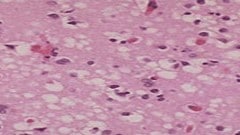Key points
- Creutzfeldt-Jakob disease (CJD) is a rapidly progressive and always fatal neurodegenerative disorder.
- It is believed to be caused by prions, disease-causing agents that can cause abnormal folding of normal proteins in the body.
- Infection usually leads to death within one year of symptom onset.
- CJD occurs worldwide and the estimated annual incidence in many countries, including the United States, has been reported to be about one to two cases per million population.

Overview
CJD is classified as a transmissible spongiform encephalopathy (TSE) along with other prion diseases that occur in humans and animals. CJD was first recognized in the 1920s. The risk of CJD increases with a person's age.
In about 85% of patients, CJD occurs as a sporadic disease with no recognizable pattern of transmission. A smaller proportion of patients (5 to 15%) develop CJD because of inherited mutations of the prion protein gene. These inherited forms include Gerstmann-Straussler-Scheinker syndrome and fatal familial insomnia.
Confirming CJD in a patient requires neuropathologic and/or immunodiagnostic testing of brain tissue obtained either at biopsy or autopsy.
Clinical features
CJD typically affects people 55 years old and older. The primary symptom is dementia with early neurologic signs.
Once symptoms begin, the patient's decline is fairly quick, with a median of 4-5 months until death.
Diagnosis
There are standard diagnostic criteria for definite, probable and possible sporadic CJD cases. There are separate diagnostic criteria for cases that may be iatrogenic and those that may be inherited. [link to diagnosis page].
Patient management
Treatment of prion diseases remains supportive. There is unfortunately no specific therapy that has been shown to stop the progression of these diseases.
Death rates
Creutzfeldt-Jakob disease deaths and age-adjusted death rate, United States, 1979–2022*

*Deaths obtained from multiple cause-of-death data include all forms of human prion disease and are based on ICD-9 and ICD-10 codes and available computerized literal death certificate data. Some modifications have been made to these data based on relevant information obtained from other surveillance mechanisms. Rates are adjusted to the US standard 2000 projected population.
Not everyone who is thought to have died from prion disease has had their brain tissue analyzed, which is required to confirm prion disease. Because of this, these case counts include people with probable CJD based on clinical tests provided a prion disease diagnosis is listed on their death certificate. A recently developed clinical laboratory test, when positive, has been shown to strongly indicate prion disease. Annual numbers of people with this positive test but no brain tissue analyses can be found on the National Prion Disease Pathology Surveillance Center website (NPDPSC Tables). More information on the test is available here.
Similar diseases
It's important to note that classic CJD is different than variant CJD. vCJD is a prion disease caused by eating cow products from cattle infected with Bovine Spongiform Encephalopathy
CJD is not related to BSE. Instead, cases occur either sporadically, via healthcare associated infections or via genetic links.
Classic CJD characteristics, as compared to variant CJD, are presented in the table here.
Resources
University of California, San Francisco: Memory and Aging Center Creutzfeldt-Jakob Disease Website
Creutzfeldt-Jakob Disease Foundation, Inc.
The UK Creutzfeldt-Jakob Disease Surveillance Unit University of Edinburgh, Scotland
- Prion disease incidence in the United State, 2003-2015 Neurology® 2020;94:1-5.
- Diagnostic and prognostic value of human prion detection in cerebrospinal fluid.Ann Neurol. 2017 Jan;81(1):79-92. doi: 10.1002/ana.24833.
- Creutzfeldt-Jakob Disease Surveillance and Diagnosis Clinical Infectious Diseases. 2005; 41:834–836.
- Creutzfeldt-Jakob Disease Not Related to a Common Venue – New Jersey, 1995 – 2004, MMWR. 2004;53(Early Release):1-4.
- Creutzfeldt-Jakob Disease in Unusually Young Patients Who Consumed Venison. Archives of Neurology, 2001;58:1673-1678.
- Creutzfeldt-Jakob Disease in the United States: 1979-1998. Journal of the American Medical Association. 2000;284(18).
- Transmissible Spongiform Encephalopathies in Humans Annu. Rev. Microbiol. 1999;53:283–314.
- Creutzfeldt-Jakob Disease Associated with Cadaveric Dura Mater Grafts.MMWR. November 14, 1997;46(45):1066-1069.
- Creutzfeldt-Jakob Disease in the United States, 1979-1994: Using National Mortality Data to Assess the Possible Occurrence of Variant Cases.EID. October-December 1996;2(4):333-337.
- Surveillance for Creutzfeldt-Jakob Disease, MMWR. August 9, 1996;45(31):665-668.
